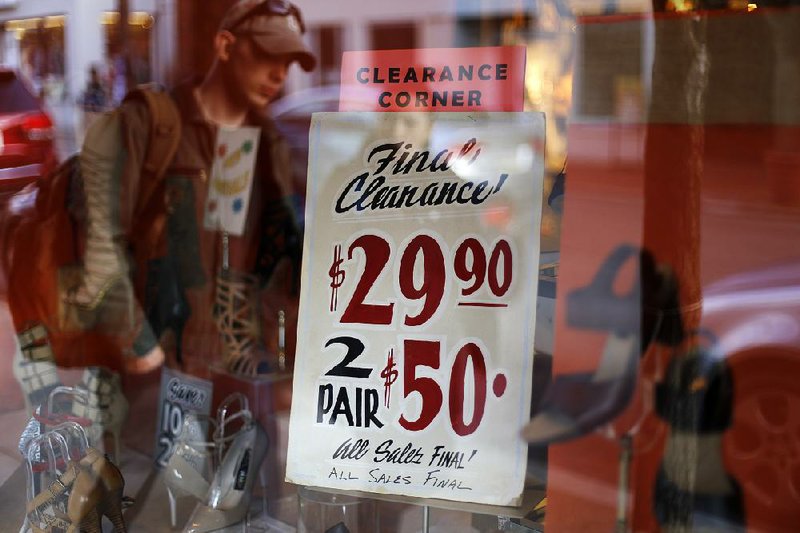WASHINGTON - Consumer spending in the U.S. rose in February by the most in three months as incomes increased, a sign that economic momentum was returning as Americans recovered from an unusually harsh winter.
Household purchases, which account for almost 70 percent of the economy,climbed 0.3 percent in February after an even weaker 0.2 percent rise in January, the Commerce Department reported Friday. The January performance was cut in half from an initial estimate of 0.4 percent.
For February, spending on autos and other durable goods fell, and much of the small gain reflected higher utility payments to pay heating costs.
Analysts said consumer spending, which accounts for 70 percent of economic activity, has slowed significantly in the January-March quarter and will hold back overall economic growth. But they are looking for a rebound in the spring as the weather improves.
Based on the weak February performance and the downward revision to January, economists at Barclays said they were trimming their forecast for overall economic growth in the first quarter to a 2 percent rate, down from a previous estimate of 2.4 percent.
Analysts believe a second quarter rebound will be driven by pent-up demand for the purchase of items such as cars that were put off during the winter storms.
“We expect consumer spending to be significantly stronger in the second quarter,” said Chris Christopher, director of consumer economics at Global Insight. “Auto sales are expected to heat up in March and for the remainder of the year.”
The report showed that after-tax income was up 0.3 percent in February, the same as in January.
The saving rate edged up slightly to 4.3 percent of after-tax income compared with January, when the saving rate was 4.2 percent.
“Looking past some of the noise in the data, the trend is for modestly stronger personal income and spending, which should accelerate throughout the year as the economy builds momentum,” Michelle Meyer, a senior U.S. economist at Bank of America Merrill Lynch in New York, said before the report.
The report showed that inflation remains low. An inflation gauge tied to consumer spending was up just 0.9 percent in February compared with a year ago, significantly below the 2 percent target set by the Federal Reserve.
The Fed last week approved another reduction in its monthly bond buying, which the central bank is doing to lower long-term interest rates and boost economic growth.
But some economists are concerned that if the Fed removes its support too quickly, it could undermine efforts to get prices rising closer to the target.
“Growth in economic activity slowed during the winter months, in part reflecting adverse weather conditions,” the Fed said in a March 19 statement.
Even so, “there is sufficient underlying strength in the broader economy to support ongoing improvement in labor-market conditions.”
Economists expect that spending will rebound in the April-June period, helping to increase overall economic growth to its strongest pace in nearly a decade.
Many analysts foresee the economy growing 3 percent for the year, after a weak first quarter. It would be the most robust annual expansion since 2005, two years before the recession began.
The National Association for Business Economics is predicting that the economy will grow 3.1 percent this year, far higher than the lackluster 1.9 percent gain in 2013.
If that forecast proves accurate, it would make 2014 the strongest year since the economy, as measured by the gross domestic product, expanded 3.4 percent in 2005.Since the recession ended in June 2009, annual growth over the past four years has averaged 2.2 percent.
The U.S. economy has been hit by a series of blows since then from a prolonged European debt crisis that hurt U.S. exports to three years of Washington budget fights that fueled uncertainty about the government’s spending and tax policies.
Tax increases and deep spending cuts that took effect in 2013 subtracted an estimated 1.5 percentage points from growth last year.
With Congress having reached a budget agreement and a deal to raise the government’s borrowing limit, companies now have more certainty about federal fiscal policies and because of that, analysts say, businesses are likely to hire more employees and and spend more.
The number of people seeking unemployment benefits last week reached its lowest level since November - an encouraging sign that hiring should be picking up. In February, U.S. employers added 175,000 jobs, far more than in the two previous months.
With more people working, more consumers will have money to spend to boost the economy, analysts believe.
Information for this article was contributed by Martin Crutsinger of The Associated Press and by Victoria Stilwell and Ainhoa Goyeneche of Bloomberg News.
Business, Pages 27 on 03/29/2014

